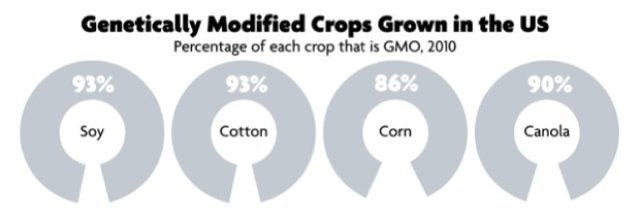Tweet
 Here we are...back to GMOs! You didn't think I was done calling-out the American food supply, did you?
Here we are...back to GMOs! You didn't think I was done calling-out the American food supply, did you?
First I told you what GMOs were. Then I told you how they negatively effect our health, and our environment.
So now, what can we do to identify them in the grocery store and more importantly, avoid them?
GMOs & Their Effects
But first here's a QUICK recap: GMOs are Genetically Modified Organisms. They are organisms (seeds, plants, animals) whose genetic material has been altered from its natural state. DNA molecules are combined with different sources to create a new set of genes, and essentially a new organism.
The US food supply is full of GMOs, but they are most prevalent in corn and soy crops. Unfortunately for us, corn and soy is found in virtually everything these days!
And while the effects on our health (rise in infertility, obesity, Diabetes, Autism, Parkinson's, asthma, cancer, etc rates) cannot yet be directly linked to GMOs, they haven't been proven safe either.
In 2009, the American Academy of Environmental Medicine publicly condemned GMOs in our food supply. Saying GMOs posed 'a serious health risk.' They also asked the U.S. government to implement an immediate moratorium on all GMO foods, and urged physicians to prescribe non-GMO diets.
 |
| GMOs have infiltrated our food supply! |
How Do We Identify Genetically Modified Foods?
Since GMO foods are not labeled in the US (like they are required to be in over 40 countries worldwide), identifying them can be somewhat difficult. But it's not impossible. All it takes is a little diligence on the part of the consumer!
 |
| Non-GMO Project seal. |
First and foremost, when buying processed/packaged goods, look for the Non-GMO Project verified seal. Products with this seal have undergone independent third-party testing to ensure they have been made to best avoid GMO ingredients. So this is a helpful tool.
The second thing you must do when buying processed foods is look at the ingredients list! Avoid at-risk ingredients (the big 4): corn, soybean, canola, and cottonseed products. Okay, this is nearly impossible, so let's move onto step three.
Pick & Choose When to Buy Organic -- the Dirty Dozen & Clean 15
When buying fruits and vegetables it's a whole different ballgame. Federal researchers found that certain types of organic produce can reduce the amount of toxins we consume on a daily basis by as much as 80%!
The "Dirty Dozen" is a list of produce that contain the highest amount of chemicals, and should ALWAYS be bought organically.
When 'conventionally' grown (non-organic, with chemicals), these fruits and vegetables tested positive for at least 47 different chemicals, with some testing positive for as many as 67. Those numbers are frightening if you ask me!
Do we really want those pesticides in our bodies? Here are the Dirty Dozen: Apples, Celery, Peaches, Strawberries, Domestic blueberries, Nectarines, Sweet bell peppers. Spinach, Kale and Collard greens, Cherries, Potatoes, Imported grapes, and Lettuce.
I know buying Organic produce can get expensive. So there's also a "Clean 15" that lists fruits and vegetables that have little to no traces of pesticides when grown 'conventionally' (non-organically).
The Clean 15 are: Onions, Avocados, Sweet corn, Pineapples, Mango, Sweet peas, Asparagus, Kiwi fruit, Cabbage, Eggplant, Cantaloupe, Watermelon, Grapefruit, Sweet potatoes, and Sweet onions.
By keeping these two lists in mind, you can avoid a great deal of harmful and unnecessary chemicals! In my opinion, it's best to have a "No Chemical Policy." Since when is it okay to consume chemicals?
 |
| Just Label It! |
The last thing we, as consumers can do, is continue to push our government to label GMO foods. We need to make these harmful foods more-easily identifiable in the grocery store!
As I mentioned before, over 40 countries worldwide label modified foods, so why is the US so far behind?
The Center for Food Safety recently started the Just Label It campaign. The CFS has petitioned the FDA demanding it require the labeling of modified foods. Go sign it! This link will send your comment/request to the FDA and President Obama.
While it may be difficult, and somewhat time-consuming, I encourage you to be diligent on your own, and pay attention to what is in your food! A chemical is never a good thing to put in our bodies.
After all, we only get one of them! Be mindful of how we are treating it!



0 comments:
Post a Comment